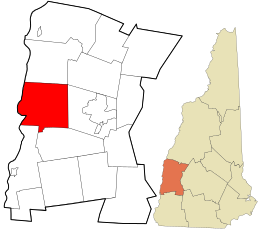Claremont, New Hampshire
| Claremont, New Hampshire | |
|---|---|
| City | |

City Hall
|
|
 Location in Sullivan County and the state of New Hampshire. |
|
| Coordinates: 43°22′20″N 72°20′15″W / 43.37222°N 72.33750°WCoordinates: 43°22′20″N 72°20′15″W / 43.37222°N 72.33750°W | |
| Country | United States |
| State | New Hampshire |
| County | Sullivan |
| Settled | 1762 |
| Incorporated | 1764 (town), 1947 (city) |
| Government | |
| • Mayor | Charlene Lovett |
| • Asst. Mayor | Victor Bergeron |
| • City Council | Carolyn Towle Scott Pope Nicholas Koloski Allen Damren Keith Raymond John Simonds Bruce Temple |
| • City Manager | Ryan W. McNutt |
| Area | |
| • Total | 44.1 sq mi (114.2 km2) |
| • Land | 43.1 sq mi (111.7 km2) |
| • Water | 1.0 sq mi (2.5 km2) 2.19% |
| Elevation | 561 ft (171 m) |
| Population (2010) | |
| • Total | 13,355 |
| • Density | 310/sq mi (119.6/km2) |
| Time zone | EST (UTC-5) |
| • Summer (DST) | EDT (UTC-4) |
| ZIP code | 03743 |
| Area code(s) | 603 |
| FIPS code | 33-12900 |
| GNIS feature ID | 0866173 |
| Website | www |
Claremont is a city in Sullivan County, New Hampshire, United States. The population was 13,355 at the 2010 census.
Before colonial settlement, the Upper Connecticut River Valley was home to the Pennacook and Western Abenaki (Sokoki) peoples, later merging with members of other Algonquin tribes displaced by the wars and famines that accompanied the European settling of the region. The Hunter Archeological Site, located near the bridge connecting Claremont with Ascutney, Vermont, is a significant prehistoric Native American site that includes seven levels of occupational evidence, including evidence of at least three longhouses. The oldest dates recorded from evidence gathered during excavations in 1967 were to AD 1300.
The city was named after Claremont, the country mansion of Thomas Pelham-Holles, Earl of Clare. On October 26, 1764, Colonial Governor Benning Wentworth granted the township to Josiah Willard, Samuel Ashley and 67 others. Although first settled in 1762 by Moses Spafford and David Lynde, many of the proprietors arrived in 1767, with a large number from Farmington, Hebron and Colchester, Connecticut. The undulating surface of rich, gravelly loam made agriculture an early occupation. Spafford was deeded land from Col. Samuel Ashley, who was given a charter to establish a ferry across the Connecticut River in 1784, the location of which is still known as Ashley's Ferry landing. Spafford was also the first man to marry in Claremont, and his son, Elijah, was the first white child to be born in the town.
...
Wikipedia
